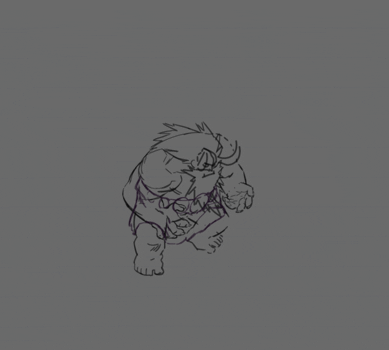The art director and lead animator on Thunder Lotus Games' Jotun take a deep dive into the choices and challenges behind the game's unique art design and animation.
October 7, 2015

Author: by Jo-Annie Gauthier, Alexandre Boyer
This Art Design Deep Dive is a new, game artist-focused spin on Gamasutra's popular Game Design Deep Dive series, which aims to shed light on specific features or mechanics within a video game in order to show how seemingly simple, fundamental design decisions aren't really that simple at all.
Check out earlier installments on the heredity system of Hero Generations, traffic systems of Cities: Skylines, and the plant-growing mechanics of Grow Home.
Also, dig into our ever-growing Deep Dive archive for developer-minded features on everything from Amnesia's sanity meter to Alien: Isolation's save system.
Who: Jo-Annie Gauthier Jotun art director
I was in charge of building the game's stylistic approach, and making sure we didn't drift too far from it! It was my first time as an art director, seeing as I have mostly worked as a 2D artist (animation, illustration, storyboarding) in gaming and publicity. Working with William Dubé on this idea for a Norse game was definitely an opportunity I did not want to miss.
Being the studio's first game, Jotun had several challenges we had to overcome: some tougher and some easier. Converging on game ideas was definitely one of the easier ones. One of the tougher ones was finding an art style that would fit the theme and still be natural for us to work with.

The more we read about Norse mythology, the more we realized the stories were heavy with meaning and emotion, and more often than not had a darker twist.
They were also sprinkled with humor and a lot of character! I feel like we would've missed the mark had we tried to go down a darker route visually and it would've probably been much heavier than our initial intent for Jotun. We wanted to even out the heavy topics like Thora's death and her task of slaying those giants with something fun and pleasant to look at, much like a lot of Norse art is colorful and full of life.

Another challenge was integrating Norse myths in a way that would be visually pleasant to the player without feeling like we were bombarding them with information.
So we made them bigger than life! Some are exploration goals, some you see simply passing by and some are breathtaking vistas. I made sure to do as much research as possible on every asset of the game that represented an existing myth (books, audio books and even Old Norse University classes online!), and then I would stylize it to add the Jotun feel to it. I think that's something a lot of people do the other way around. In my eyes, my art for the game was meant to serve the mythology we wanted to share, and not the other way around.

I'd dare to say the jotuns themselves represent the most inaccurate depictions we have in the the game (along with the horned helmets).
In the mythology, jotuns (or rather, jotnar) are simply bigger humans and there are as many of them as there are humans or gods. However, we wanted them to feel connected to their realms and to differentiate them from the Gods as much as possible. That’s why they were made into elementals.
Much as the first giant—Ymir—was born of fire and ice, we wanted to carry that idea onto the five jotuns Thora has to defeat. One is made of a mountain and gold, another of clouds and lightning (and fury!), another of ice and blizzards... And since elemental beings are sort of common in games, making ours unique and fresh was quite a challenge.

It is worth mentioning that in the first few months of production I worked on the game, I was the only one producing both the concepts and the final background assets while Alex Boyer produced all the animations for Thora, the environment and the jotuns.
After our success at PAX East, we realized there would not be enough time for us to work alone, so we hired a second animator named Nicolas Grenier and a second 2D artist, Marie-Christine Levesque, to help me with the final render of the backgrounds. In July, a third artist, Myriam Boisclair, joined us to give us the very much needed help for the final stretch.
Choosing to go with 2D animation was not as hard as one would think it was. Both Alex Boyer and I have the same traditional animation education with different strengths and experiences, and we are passionate about what we do. We had previously worked with Will at another company and knew each other's work, so when he reached out to us for the Kickstarter, it was an immediate yes on my part.
Another reason we chose 2D is that we wanted to tell a story. Many stories, many myths, and hand drawn art is reminiscent of epic storybooks. It's very nostalgic for us. We grew up watching Disney, Don Bluth as well as many 80's-90's animes and early morning cartoons.
We applied a lot of classic animation rules to the game, such as storyboarding, composition, silhouetting of the characters, pacing, etc. as we tried to tell an immersive, interactive story with huge boss fights. All of Jotun's design is very deliberate! In the end we added Thora's rather simple narrative as a reason for her to reminisce the stories of her people and to pique the player's curiosity about Norse mythology.

I am definitely happy with the final look and feel of Jotun. It truly feels great to know what was a vague description for a “cool viking game with a badass shield-maiden protagonist” almost two years ago is now in digital stores and is enjoyed by so many. Sure, we had a few hiccups along the way, but all startups do! I'm confident we have learned a lot, like planning the art production better, and will do even better on our next game.
Who: Alexandre Boyer, lead animator on Jotun
Hi! I’ll be talking about our animation style and system.
Animating Jotun was very fun and challenging. I couldn’t miss the opportunity to build something with the rest of the nice and talented folks at Thunder Lotus studio. We call our animation style ‘’hand-drawn’’ rather than traditional, since we use a lot of flash-style trickery using the Toonboom software. There’s a lot of drawing involved, but we try not to have to redraw every frame from scratch.
Making a top-down 2D action game is not a simple task, since our characters must move in all directions. The most obvious example would be the old 2D Zelda games, The Minish Cap being the last one of those.
Their animation system is quite simple, but it works wonderfully since the style is so cartoony and the animation clips themselves are very good. Dividing the environment into an X and Y grid also made having only 4 angles of animation (North, East, South, West) seem natural.

For Jotun, we wanted the game to feel like a living cartoon. Since our style is closer to semi-realism, we needed to avoid ‘’pops’’ you feel in between animation clips. This meant we needed to draw Thora, the main protagonist, in 8 angles:

In order to save time, we only drew 5 of them since North-East, East and South-East can be flipped to make their western equivalents. This causes the axe to switch sides, but the time saved was well spent on other game content.
We also animated a transition from idle to run. This transition doesn’t affect the in-game movement of the character, so as to not remove responsiveness, but it really helps make the exploration flow more naturally

The moment where the ‘’pop’’ between angles is the most felt is when running through the environment. I wish I could’ve done 16 angles for the run (the rest of the animations are fine with 8 angles), but hopefully, we’ll budget this in for our next project.
For the jotuns, we mostly had to limit ourselves to 4 angles (the big guys take a long time to draw). In order to avoid pops between the angles, we drew turn animations. It makes the jotun feel less responsive, but it works out well since they’re supposed to be big hulking creatures and responsiveness is a different issue when it comes to NPCs.

It was also necessary to cut the jotuns up to allow Thora to move around them and between their legs while being correctly sorted.

Finally, making a finished animation in 2D can be time-intensive so we always start prototyping with rough animations. It’s much quicker to iterate on programming and game design elements this way. Here's what that looks like:




I have to say Jotun was the most satisfying project I have ever worked on. I can’t wait to start something new with the team here at Thunder Lotus. Thanks for reading!
You May Also Like






